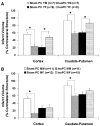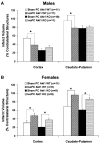Gender-specific response to isoflurane preconditioning in focal cerebral ischemia
- PMID: 17264860
- PMCID: PMC2266686
- DOI: 10.1038/sj.jcbfm.9600444
Gender-specific response to isoflurane preconditioning in focal cerebral ischemia
Abstract
Inhalation anesthetics are effective chemical preconditioning agents in experimental cerebral ischemia. However, previous work has been performed exclusively in male animals. We determined if there is a gender difference in ischemic outcome after isoflurane preconditioning (IsoPC), and if this sex-specific response is linked to differences in Akt phosphorylation or expression of neuronal inducible cell-death putative kinase (NIPK), a negative modulator of Akt activation. Young and middle-aged male and female mice were preconditioned for 4 h with air (sham PC) or 1.0% IsoPC and recovered for 24 h. Cortices were subdissected from preconditioned young male and female mice for measurement of Akt phosphorylation (Western blot) and NIPK mRNA (quantitative polymerase chain reaction). Additional cohorts underwent 2 h of reversible middle cerebral artery occlusion. Lastly, male and female Akt1(+/+) and Akt1(-/-) mice were studied to determine if gender differences in ischemic outcome after IsoPC is Akt1-dependent. Infarction volume was determined at 22 h reperfusion (2,3,5-triphenyltetrazolium chloride). As expected, IsoPC decreased ischemic damage as compared with sham PC in young and middle-aged male mice. In contrast, IsoPC markedly increased infarction in young female mice and had no effect in middle-aged female mice. Cortical phospho-Akt was increased by IsoPC versus sham PC only in male mice. No increase was observed in IsoPC female mice. NIPK mRNA was higher in female mice than in male mice regardless of preconditioning status. Male IsoPC neuroprotection was lost in Akt1-deficient male mice. We conclude that IsoPC is beneficial only in ischemic male brain and that sex differences in IsoPC are mediated through Akt activation and basal NIPK expression.
Figures



Similar articles
-
Estradiol attenuates neuroprotective benefits of isoflurane preconditioning in ischemic mouse brain.J Cereb Blood Flow Metab. 2008 Nov;28(11):1824-34. doi: 10.1038/jcbfm.2008.70. Epub 2008 Jul 9. J Cereb Blood Flow Metab. 2008. PMID: 18612317 Free PMC article.
-
Isoflurane preconditioning induces neuroprotection by attenuating ubiquitin-conjugated protein aggregation in a mouse model of transient global cerebral ischemia.Anesth Analg. 2010 Aug;111(2):506-14. doi: 10.1213/ANE.0b013e3181e45519. Epub 2010 Jul 7. Anesth Analg. 2010. PMID: 20610552
-
The effects of isoflurane pretreatment on cerebral blood flow, capillary permeability, and oxygen consumption in focal cerebral ischemia in rats.Anesth Analg. 2010 May 1;110(5):1412-8. doi: 10.1213/ANE.0b013e3181d6c0ae. Epub 2010 Mar 19. Anesth Analg. 2010. PMID: 20304986
-
Inhalational anesthetics as preconditioning agents in ischemic brain.Curr Opin Pharmacol. 2008 Feb;8(1):104-10. doi: 10.1016/j.coph.2007.09.005. Epub 2007 Oct 24. Curr Opin Pharmacol. 2008. PMID: 17962069 Free PMC article. Review.
-
Inhalational anesthetics as neuroprotectants or chemical preconditioning agents in ischemic brain.J Cereb Blood Flow Metab. 2007 Jun;27(6):1108-28. doi: 10.1038/sj.jcbfm.9600410. Epub 2006 Oct 18. J Cereb Blood Flow Metab. 2007. PMID: 17047683 Free PMC article. Review.
Cited by
-
Sevoflurane: an opportunity for stroke treatment.Med Gas Res. 2024 Dec 1;14(4):175-179. doi: 10.4103/2045-9912.386952. Epub 2024 Mar 28. Med Gas Res. 2024. PMID: 39073324 Free PMC article. Review.
-
MicroRNA responses to focal cerebral ischemia in male and female mouse brain.Front Mol Neurosci. 2014 Feb 11;7:11. doi: 10.3389/fnmol.2014.00011. eCollection 2014. Front Mol Neurosci. 2014. PMID: 24574964 Free PMC article.
-
Delayed postconditioning protects against focal ischemic brain injury in rats.PLoS One. 2008;3(12):e3851. doi: 10.1371/journal.pone.0003851. Epub 2008 Dec 10. PLoS One. 2008. PMID: 19066627 Free PMC article.
-
Isoflurane preconditioning neuroprotection in experimental focal stroke is androgen-dependent in male mice.Neuroscience. 2010 Aug 25;169(2):758-69. doi: 10.1016/j.neuroscience.2010.05.038. Epub 2010 May 24. Neuroscience. 2010. PMID: 20580788 Free PMC article.
-
Ginsenoside-Rb1 for Ischemic Stroke: A Systematic Review and Meta-analysis of Preclinical Evidence and Possible Mechanisms.Front Pharmacol. 2020 Mar 31;11:285. doi: 10.3389/fphar.2020.00285. eCollection 2020. Front Pharmacol. 2020. PMID: 32296332 Free PMC article.
References
-
- Ardelt AA, McCullough LD, Korach KS, Wang MM, Munzemaier DH, Hurn PD. Estradiol regulates angiopoietin-1 mRNA expression through estrogen receptor-α in a rodent experimental stroke model. Stroke. 2005;36:337–41. - PubMed
-
- Bederson JB, Pitts LH, Germano SM, Nishimura MC, Davis RL, Bartkowski HM. Evaluation of 2,3,5-triphenyltetrazolium chloride as a stain for detection and quantification of experimental cerebral infarction in rats. Stroke. 1986;17:1304–8. - PubMed
-
- Bingham D, Macrae IM, Carswell HV. Detrimental effects of 17β-oestradiol after permanent middle cerebral artery occlusion. J Cereb Blood Flow Metab. 2005;25:414–20. - PubMed
-
- Bond R, Rerkasem K, Cuffe R, Rothwell PM. A systematic review of the associations between age and sex and the operative risks of carotid endarterectomy. Cerebrovasc Dis. 2005;20:69–77. - PubMed
-
- Brunet A, Datta SR, Greenberg ME. Transcription-dependent and -independent control of neuronal survival by the PI3K–Akt signaling pathway. Curr Opin Neurobiol. 2001;11:297–305. - PubMed
Publication types
MeSH terms
Substances
Grants and funding
LinkOut - more resources
Full Text Sources
Research Materials
Miscellaneous

